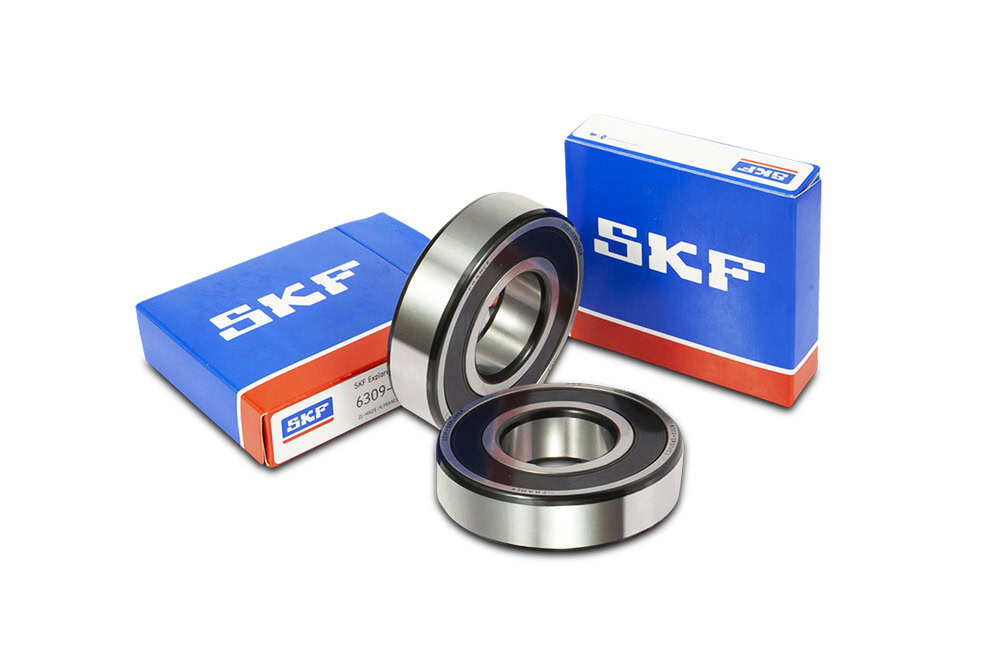In the power transmission and rotating components sector, protection against contaminants is essential to ensure the operational longevity and efficiency of rolling bearings. SKF, a leading company in motion solutions design, has developed various sealing types to protect its bearings from external elements that could compromise their functionality.
Two of the most common solutions are 2RS1 and 2RSH seals, both designed to provide protection on both sides of the bearing (hence the “2” designation). However, these seals have significant differences in design, performance, and ideal applications, which we will explore in this article.
1. The Importance of Seals in SKF Bearings
Ball bearings operate in often critical environmental conditions where dust, moisture, chemicals, and other contaminants can accelerate wear and reduce operational life. To protect bearings and ensure their proper functioning, SKF uses nitrile rubber (NBR) seals reinforced with a steel ring, which improves mechanical resistance and component protection.
Adopting an efficient seal provides:
- Extended bearing life, thanks to protection against dirt and moisture.
- Reduced maintenance needs, lowering costs and machine downtime.
- Improved energy efficiency, preventing excessive friction caused by internal contamination.
The 2RS1 and 2RSH seals are two of the most widely used options for excellent protection in industrial applications, but they have key differences that influence their selection.
2. Features of 2RS1 Seals
The 2RS1 designation identifies a nitrile rubber (NBR) seal reinforced with an internal metal plate. This design provides an effective barrier against external contaminants, making it suitable for environments with high exposure to dust, moisture, and industrial residues.
Main Features of 2RS1:
- Material: Nitrile rubber (NBR) with a metal insert for greater mechanical resistance.
- Structure: The sealing lip is in contact with the inner ring of the bearing for effective protection.
- Protection: Excellent resistance to dust, moisture, and fine particles.
- Friction: Higher compared to non-contact seals, leading to a slight increase in operating temperature at high speeds.
- Typical Applications: Industrial sectors with contaminated environments or risk of liquid infiltration, such as electric motors, agricultural machinery, and mechanical transmissions.
3. Features of 2RSH Seals
The 2RSH designation represents an optimized version of SKF’s sealing technology. This seal is designed to reduce friction while maintaining a high level of contamination protection.
Main Features of 2RSH:
- Material: Advanced formulation nitrile rubber (NBR) for enhanced resistance.
- Structure: Sealing lip with an optimized profile to reduce friction and improve energy efficiency.
- Protection: Improved compared to 2RS1, with greater ability to prevent impurity ingress.
- Friction: Reduced compared to the 2RS1 version, allowing for more efficient operation at high speeds.
- Typical Applications: Systems where reducing friction is essential to improve energy efficiency, such as high-speed machinery and precision application bearings.
4. Performance Comparison
| Feature | 2RS1 | 2RSH |
|---|---|---|
| Material | NBR rubber with metal insert | Advanced NBR rubber |
| Contaminant Resistance | High | Very High |
| Friction | Medium-High | Medium-Low |
| Durability at High Speeds | Lower | Higher |
| Energy Efficiency | Medium | High |
| Recommended Applications | High exposure to contaminants | High-speed applications with low friction requirements |
As shown in the table, the 2RS1 seal is better suited for contaminated environments, while the 2RSH provides superior performance at high speeds and lower friction.
5. Final Considerations
The choice between 2RS1 and 2RSH depends on the operating conditions of the bearing and the application priorities:
- If the primary objective is maximum protection against dust and moisture, the 2RS1 is the ideal choice.
- If a solution with lower friction and greater energy efficiency is needed, the 2RSH is the best option.
Both solutions provide effective protection, but with advancements in materials and design, the 2RSH stands out as the more advanced solution for modern industrial needs.
To achieve the best performance from your system, it is essential to carefully assess operating conditions and select the most suitable bearing for your needs.

